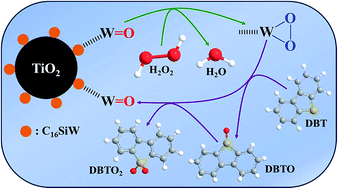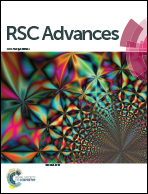TiO2 microspheres supported polyoxometalate-based ionic liquids induced catalytic oxidative deep-desulfurization†
Abstract
A series of TiO2 microspheres supported polyoxometalate-based ionic liquids (POM-ILs) with different tungsten–titanium molar ratios and different carbon chains ILs were successfully prepared. The supported catalysts were characterized by TG, FT-IR, Raman, Nitrogen adsorption–desorption isotherms, XPS and SEM. It is confirmed that the POM-ILs were indeed immobilized on TiO2 microspheres and the structures were maintained. The appropriate morphology and loading of the supported catalyst was obtained with [C16mim]4SiW12O40 (C16SiW) IL and the tungsten–titanium molar ratio was 0.1 (0.1-C16SiW–TiO2). This heterogeneous catalyst strategy makes the usage of ionic liquid decrease sharply. The supported catalyst 0.1-C16SiW–TiO2 exhibited high catalytic activity in the extractive coupled catalytic oxidative desulfurization (ECODS) system under mild conditions. The removal of dibenzothiophene (DBT) reached 95.3% with low-dosage oxidant (the molar ratio of H2O2 and DBT is only 2), which means high efficiency utilization of H2O2 was achieved in this system. Moreover, DBT could be removed completely with a little excess oxidant. Furthermore, the 0.1-C16SiW–TiO2 catalyst showed excellent reusing ability, the desulfurization efficiency had no obvious decrease after recycling for 8 times, which made it a promising catalyst in oxidative desulfurization process.


 Please wait while we load your content...
Please wait while we load your content...